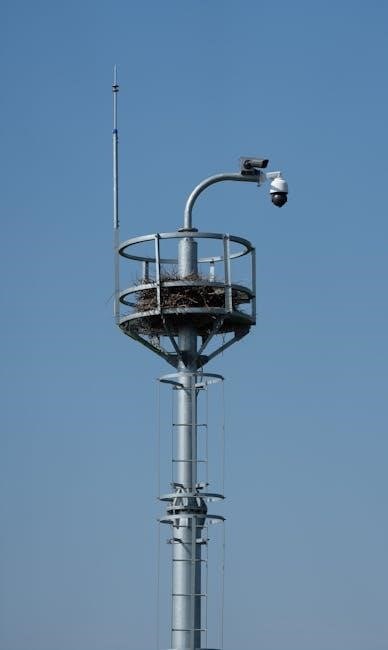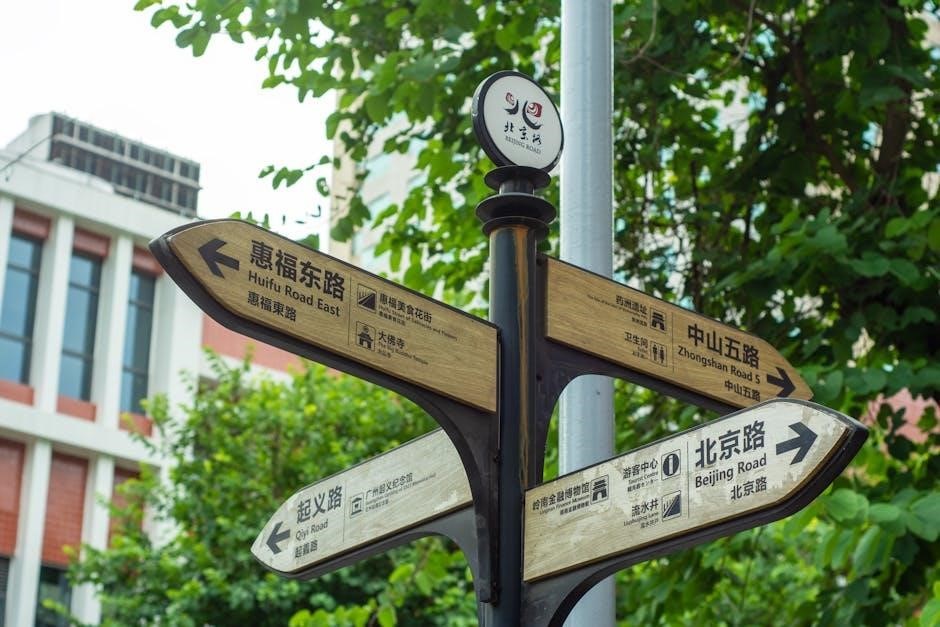A guide pole is a vertical structure used to provide directional guidance, support signs, or mark pathways. They are essential for navigation in transportation, urban, and industrial environments.
Definition and Purpose
A guide pole, also known as a directional pole, is a vertical structure designed to offer support, safety, and navigational guidance in various environments; Its primary purpose is to provide clear direction, mark pathways, or support signs and signals. Guide poles are essential in transportation systems, urban areas, and industrial settings, ensuring safety and efficiency. They are typically durable, weather-resistant, and strategically placed to enhance visibility and accessibility. Their consistent design and placement help users navigate spaces confidently, making them a critical component of modern infrastructure.
Historical Background
Guide poles have their roots in ancient civilizations, where simple wooden or stone markers were used to denote pathways and boundaries. Over time, their design evolved to incorporate metals and durable materials. In the mid-19th century, guide poles became integral to railway systems, aiding in navigation and safety. Their use expanded into urban and industrial settings during the Industrial Revolution. Early guide poles were often handcrafted, while modern manufacturing introduced standardized designs. This historical progression highlights their adaptability and enduring importance in guiding human movement across diverse environments and eras.
Modern Applications
Today, guide poles are integral to modern infrastructure, serving as critical components in traffic management, public transportation, and industrial settings. They are used to mount signage, lighting, and surveillance systems, enhancing safety and efficiency. In urban areas, they support smart city initiatives by integrating IoT technology for real-time data collection. Guide poles also play a key role in parking guidance systems, directing drivers to available spots. Their versatility extends to warehouses, where they assist in material handling and navigation. Modern designs emphasize durability and sustainability, ensuring they meet the demands of contemporary environments while promoting eco-friendly practices.

Design and Construction of Guide Poles
Guide poles are engineered for durability and functionality, using advanced materials and manufacturing techniques to ensure strength and resistance to environmental factors. Their designs meet international standards and adapt to various applications.
Materials Used
Guide poles are typically made from durable materials such as steel, aluminum, and concrete to ensure longevity and resistance to environmental factors. Steel is favored for its strength and versatility, while aluminum offers lightweight and corrosion-resistant properties. Concrete poles are often used in heavy-duty applications for their robustness. Additionally, materials like fiberglass and PVC are employed for their weather resistance and low maintenance requirements. The choice of material depends on the intended use, environmental conditions, and budget constraints. Each material ensures the pole can withstand various stresses and provide reliable service over time.
Manufacturing Process
The manufacturing of guide poles involves several steps, starting with material selection and cutting to the required length. The pole is then fabricated through processes like welding or molding, depending on the material. A protective coating is applied to enhance durability and resistance to environmental factors. Additional features, such as reflective strips or mounting brackets, are added before the pole undergoes quality testing. Finally, the pole is packaged and prepared for distribution. This process ensures the guide pole is both functional and long-lasting for its intended application.
Standard Dimensions and Specifications
Guide poles are manufactured in standard dimensions to ensure uniformity and functionality. Typically, they range in height from 3 to 12 meters and have diameters between 50 to 150 millimeters. Standard specifications include material thickness, height, and mounting options, adhering to international and local regulations. Common materials are steel, aluminum, or fiberglass, each offering durability and resistance to environmental factors. Compliance with standards like ASTM or EN ensures reliability and consistency across applications.

Installation and Maintenance
Proper installation involves site preparation, concrete setting, and leveling. Regular maintenance includes inspections, cleaning, and repair to ensure longevity and functionality of guide poles.
Steps for Proper Installation
Installing a guide pole involves several key steps to ensure stability and longevity. First, prepare the site by clearing debris and leveling the ground. Next, dig a hole with appropriate depth and diameter for the pole’s height and material. Place the pole in the hole, ensuring it is straight and properly aligned using a level tool. Secure the pole with concrete, filling the hole completely and allowing it to set. Finally, check the pole’s level and make any necessary adjustments for a secure installation.
Regular Maintenance Requirements
Regular maintenance ensures guide poles remain durable and functional. Inspect poles annually for signs of wear, rust, or damage. Clean surfaces to maintain visibility and check for loose fittings or signs of instability. Replace damaged or faded signs promptly. Apply protective coatings to prevent corrosion, especially in harsh weather conditions. Ensure proper alignment and tighten any loose bolts or brackets. Address any issues immediately to prevent accidents and extend the lifespan of the guide pole. Routine upkeep is vital for safety and effectiveness in guiding traffic or pedestrians.
Troubleshooting Common Issues
Common issues with guide poles include misalignment, damage from accidents, or worn-out reflective coatings. Inspect the pole regularly for dents, rust, or loose bases. Use a level to ensure proper alignment and tighten any loose bolts. Replace faded or damaged signs promptly to maintain visibility. If the pole is leaning, check the foundation and rebury it securely. Address vandalism or accidental damage by repainting or replacing components. Document issues and schedule repairs to prevent further deterioration and ensure safety for users. Regular checks can help identify problems early.

Guide Poles in Transportation Systems
Guide poles are essential in transportation for traffic management, supporting signs, and marking pathways. They enhance safety and navigation in public transit, roads, and parking areas.
Role in Traffic Management
Guide poles play a crucial role in traffic management by providing clear directional guidance to drivers and pedestrians. They are often equipped with reflective signs, arrows, or markings to enhance visibility, especially at night or in low-light conditions. These poles help regulate traffic flow, prevent accidents, and ensure smooth navigation through complex intersections or construction zones. Additionally, they are used to mark pedestrian crossings, bike lanes, and road dividers, contributing to overall road safety and efficiency in urban and highway environments.
Use in Public Transportation
Guide poles are integral to public transportation systems, providing passengers with clear directional guidance and essential information. They are commonly found at bus stops, train stations, and airports, offering details such as route maps, timetables, and service announcements. These poles often feature illuminated signs or digital displays to enhance visibility and accessibility. By ensuring travelers can navigate easily, guide poles improve the overall efficiency and user experience of public transportation networks, making them a vital component of modern transit infrastructure.
Application in Parking Systems
Guide poles play a crucial role in parking systems by providing clear directional guidance and enhancing navigation. They are often installed in parking garages and lots to indicate parking spaces, guide traffic flow, and support signs with instructions or availability information; Equipped with reflective or illuminated markers, these poles improve visibility and accessibility, especially in large or multi-level facilities. By streamlining the parking process, guide poles reduce congestion and enhance overall efficiency, ensuring a safer and more organized parking experience for users.

Guide Poles in Industrial Settings
Guide poles enhance safety and efficiency in industrial environments by marking pathways, supporting equipment, and ensuring clear navigation for workers and machinery, reducing accidents and downtime.
Warehouse Navigation
Guide poles play a crucial role in optimizing warehouse navigation by clearly marking pathways, designating storage areas, and ensuring smooth workflow. They help prevent accidents by separating pedestrian paths from forklift routes and machinery corridors. Strategically placed poles enhance visibility, especially in large facilities, guiding workers and equipment efficiently. Reflective markers and signs on poles improve safety and compliance with industrial standards. This organized system minimizes operational disruptions, ensuring a safer and more productive environment for warehouse operations.
Material Handling Systems
Guide poles are integral to material handling systems, ensuring efficient workflow and organization. They are used to direct conveyors, mark storage zones, and guide automated systems. These poles enhance operational efficiency by providing clear visual cues, reducing errors in inventory management. Durable and visible, guide poles are essential for streamlining logistics, integrating seamlessly with warehouse automation, and maintaining smooth operations in industrial environments. Their strategic placement ensures materials are moved safely and accurately, optimizing overall production processes.
Workplace Safety Applications
Guide poles play a crucial role in workplace safety, ensuring clear visibility and hazard identification. They are often used to mark dangerous zones, such as chemical storage areas or heavy machinery paths. Reflective materials and bright colors enhance visibility, reducing accident risks. Guide poles also support emergency exit signage and first aid directions, aiding in rapid response during incidents. Their strategic placement ensures compliance with safety regulations, fostering a secure working environment and minimizing workplace hazards.

Guide Poles in Urban Infrastructure
Guide poles are integral to urban infrastructure, supporting streetlights, traffic signals, and utility lines. They enhance navigation, safety, and community accessibility, serving as vital urban landmarks.
Street Lighting and Signage
Guide poles play a crucial role in urban infrastructure by supporting streetlights and directional signage. They ensure proper illumination for pedestrian and vehicular safety, enhancing visibility at night. Additionally, guide poles are used to mount traffic signs, providing clear navigation for drivers and pedestrians. Their durability and strategic placement make them essential for maintaining urban mobility and order. They also contribute to the aesthetic and functional design of cityscapes, ensuring efficient traffic flow and community accessibility.
Utility Line Support
Guide poles are integral to utility line support, providing structural stability for cables, wires, and other essential infrastructure; They help organize and elevate power lines, communication cables, and fiber optics, preventing tangles and damage. This ensures reliable energy distribution and connectivity. Durable materials like steel and concrete are often used to withstand environmental stresses. By maintaining utility lines off the ground, guide poles reduce the risk of outages and enhance public safety, playing a vital role in urban and rural utility networks.
Emergency Response Systems
Guide poles play a crucial role in emergency response systems by providing visible markers and access points for critical infrastructure. They often feature emergency contact systems, such as call boxes or panic buttons, enabling quick communication during crises. Strategically placed in public areas, these poles ensure rapid response times for emergency services. Many guide poles are equipped with integrated lighting or reflective materials, enhancing visibility and accessibility, especially in isolated or low-light environments. Their durability ensures reliability in adverse conditions, making them indispensable for public safety and emergency preparedness.

Environmental Considerations
Guide poles are designed to withstand harsh weather conditions, ensuring durability and minimal environmental impact. Eco-friendly materials are increasingly used to reduce their ecological footprint.
Weather Resistance and Durability
Guide poles are crafted from materials like galvanized steel, aluminum, and treated wood, ensuring resilience against rain, snow, and extreme temperatures. Protective coatings and finishes further enhance durability, preventing rust and corrosion.
Eco-Friendly Material Options
Guide poles can now be made from eco-friendly materials like recycled steel, bamboo, and sustainably sourced wood. These options reduce environmental impact while maintaining durability. Low-VOC coatings and recyclable components further enhance sustainability, aligning with green building standards. Eco-conscious manufacturers prioritize these materials to lower carbon footprints and promote circular economy practices. As demand for environmentally responsible infrastructure grows, guide poles are adapting to meet these needs without compromising functionality or longevity.
Impact on Urban Landscapes
Guide poles significantly influence urban aesthetics and functionality, serving as essential navigational aids while blending into cityscapes. They enhance accessibility, safety, and visual order, particularly in densely populated areas. Modern designs often integrate seamlessly with architectural styles, contributing to a cohesive urban environment. Additionally, guide poles support smart city initiatives by housing sensors or cameras, fostering technological integration. Their presence ensures efficient movement and information dissemination, making them a vital component of modern urban infrastructure and planning.

Standards and Regulations
Standards and regulations for guide poles ensure safety, durability, and environmental compliance, covering design, installation, and maintenance requirements, with regular inspections mandated.
International Standards
International standards for guide poles ensure consistency in design, materials, and installation across global markets. Organizations like ISO and ASTM provide detailed specifications for height, material strength, and reflectivity. These standards also address safety, durability, and environmental considerations, ensuring guide poles meet universal requirements. Compliance with international norms facilitates seamless integration into global transportation systems and urban infrastructure, while also promoting uniformity in manufacturing and deployment. Regular updates to these standards reflect advancements in technology and evolving safety needs, ensuring guide poles remain effective and reliable worldwide.
Local Building Codes
Local building codes regulate guide pole installations to ensure safety and suitability for specific regions. These codes often dictate height restrictions, material durability, and visibility standards. They may require permits and inspections to guarantee compliance with local regulations. Codes vary by jurisdiction, adapting to unique environmental or urban challenges. Compliance with local codes ensures guide poles align with community needs while maintaining safety and functionality. These regulations are regularly updated to reflect new technologies and urban development requirements, ensuring guide poles remain effective and compliant within their operational environments.
Compliance Requirements
Compliance requirements for guide poles ensure they meet safety, durability, and functionality standards. These requirements often include adherence to local, national, or international regulations, permits, and periodic inspections. Guide poles must comply with specific design and material standards to withstand environmental conditions and operational stresses. Documentation and certification may be necessary to verify compliance, ensuring public safety and structural integrity. Non-compliance can lead to legal penalties or removal, making adherence to these requirements critical for both functionality and legal standing. Regular updates to compliance standards ensure guide poles remain safe and effective in their applications.

Innovations in Guide Pole Technology
Modern guide poles now integrate smart technologies, such as IoT sensors and solar power, enhancing functionality and efficiency. These innovations improve durability and energy efficiency, supporting sustainable urban development.
Smart Guide Poles
Smart guide poles are equipped with IoT sensors, solar power, and communication systems, enabling real-time data collection and energy efficiency. These poles support smart city initiatives by providing connectivity and sustainability.
Integration with IoT
Integration with IoT enables guide poles to connect with smart city networks, enhancing functionality through real-time data exchange. Sensors embedded in poles monitor environmental conditions, traffic flow, and energy usage, providing actionable insights. IoT connectivity allows for remote monitoring and control, ensuring efficient resource management. This integration supports smart lighting, traffic management, and emergency response systems, making urban environments safer and more efficient. IoT-enabled guide poles are pivotal in achieving smart city goals by fostering connectivity and data-driven decision-making.
Future Trends
Future trends for guide poles include enhanced sustainability, integration of renewable energy sources, and smarter designs. Eco-friendly materials like recycled steel and composite polymers will dominate manufacturing. Energy-efficient lighting and solar-powered systems will reduce environmental impact. Technological advancements, such as embedded sensors for real-time data collection, will improve functionality. Predictive maintenance using AI and machine learning will extend pole longevity. Interactive screens and augmented reality integration may emerge, offering dynamic information sharing. These innovations aim to create safer, more efficient, and environmentally conscious guide pole systems for modern urban and industrial needs.

Case Studies and Examples
Guide poles are widely used in urban and industrial settings, providing clear navigation and safety. Real-world applications include traffic management, warehouse direction, and emergency response systems.
Successful Implementations
Guide poles have proven effective in enhancing navigation and safety across various environments. In urban areas, they guide pedestrians and drivers, improving traffic flow and reducing accidents. Industrial settings benefit from their use in warehouse navigation, optimizing material handling and workplace efficiency. Additionally, guide poles are integral to emergency response systems, providing critical directional support during crises. Their versatility and durability ensure long-term functionality, making them a reliable solution for diverse applications.
Lessons Learned
Experience with guide poles highlights the importance of proper installation and maintenance. Ensuring stability and visibility is crucial for safety and functionality. Regular inspections and timely repairs prevent deterioration. Material selection should prioritize durability and weather resistance. Clear signage and reflective coatings enhance visibility, especially in low-light conditions. Collaboration with local authorities ensures compliance with regulations. Addressing these factors maximizes the effectiveness and longevity of guide poles in various applications.
Real-World Applications
Guide poles are widely used in transportation systems to direct traffic flow and mark pathways. They are essential for parking guidance, indicating spaces and regulating vehicle movement. In industrial settings, they navigate forklifts and workers, enhancing safety and efficiency. Guide poles also serve in emergency response systems, marking emergency exits and routes. Their applications extend to urban landscapes, supporting streetlights and signage. By providing clear directional cues, guide poles play a vital role in ensuring smooth operations across various sectors, from public spaces to industrial facilities.
Guide poles are essential for navigation, safety, and efficiency in transportation, urban, and industrial settings. Their versatility and critical role in modern infrastructure underscore their enduring importance and future applications.
Guide poles are vertical structures designed to provide directional guidance, support signs, or mark pathways. They are essential in transportation, urban, and industrial environments for navigation and safety. Historically, guide poles have evolved from simple markers to sophisticated structures with advanced materials and functionality. Modern applications include traffic management, public transportation, and workplace safety. Their design and construction involve durable materials and precise manufacturing processes. Proper installation and maintenance ensure longevity and effectiveness. Guide poles also play a role in urban infrastructure and emergency response systems, highlighting their versatility and importance in modern society. They remain a critical component of efficient and safe environments.
Final Thoughts
Guide poles are indispensable structures that enhance navigation, safety, and organization across various environments. Their versatility in transportation, urban, and industrial settings underscores their importance in modern infrastructure. By providing clear guidance and support, guide poles contribute significantly to efficient systems and public safety. Their design and functionality continue to evolve, ensuring durability and adaptability to changing needs. As essential elements in both practical and aesthetic contexts, guide poles remain vital components of well-planned environments, fostering order and ease of movement for everyone.
